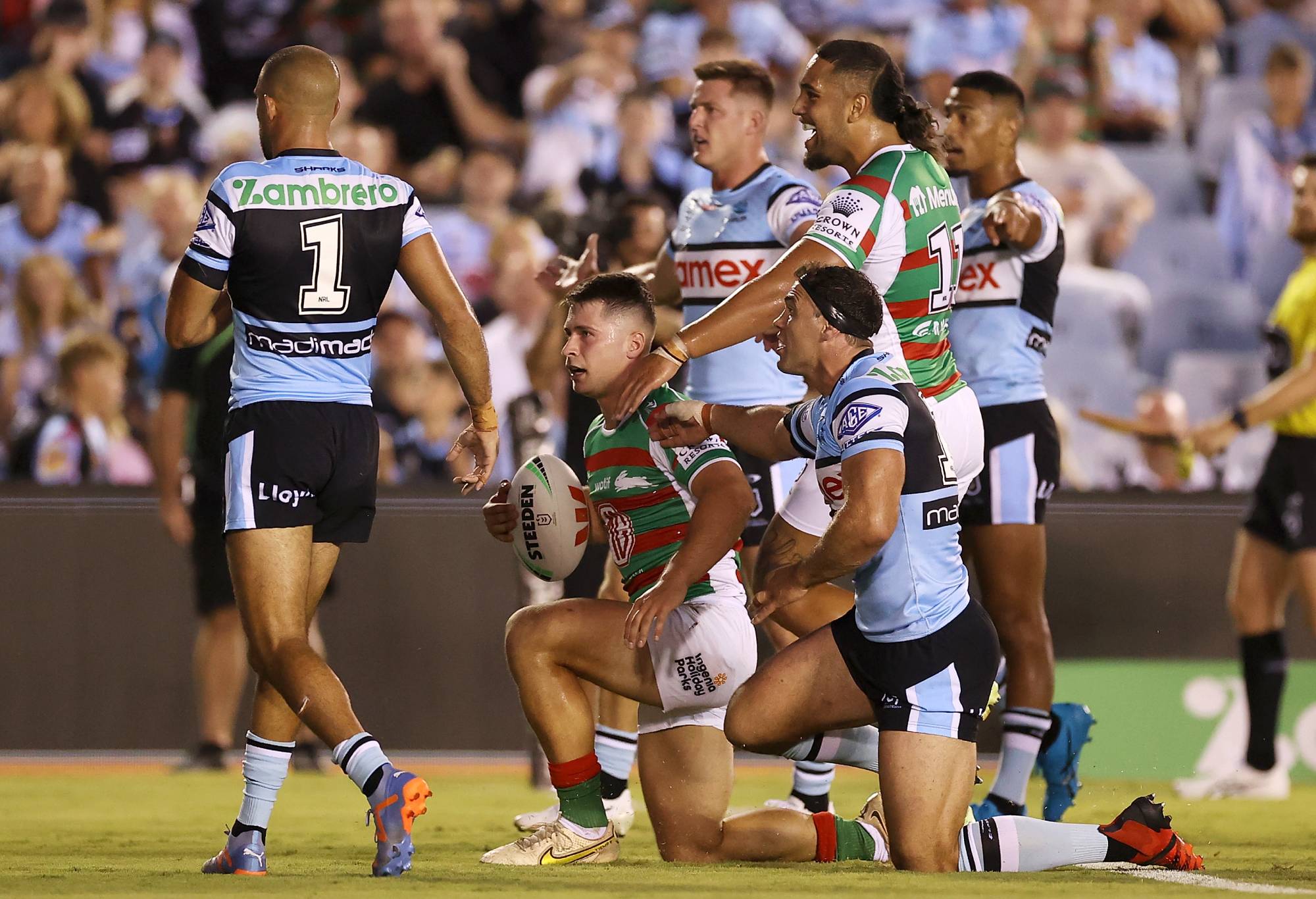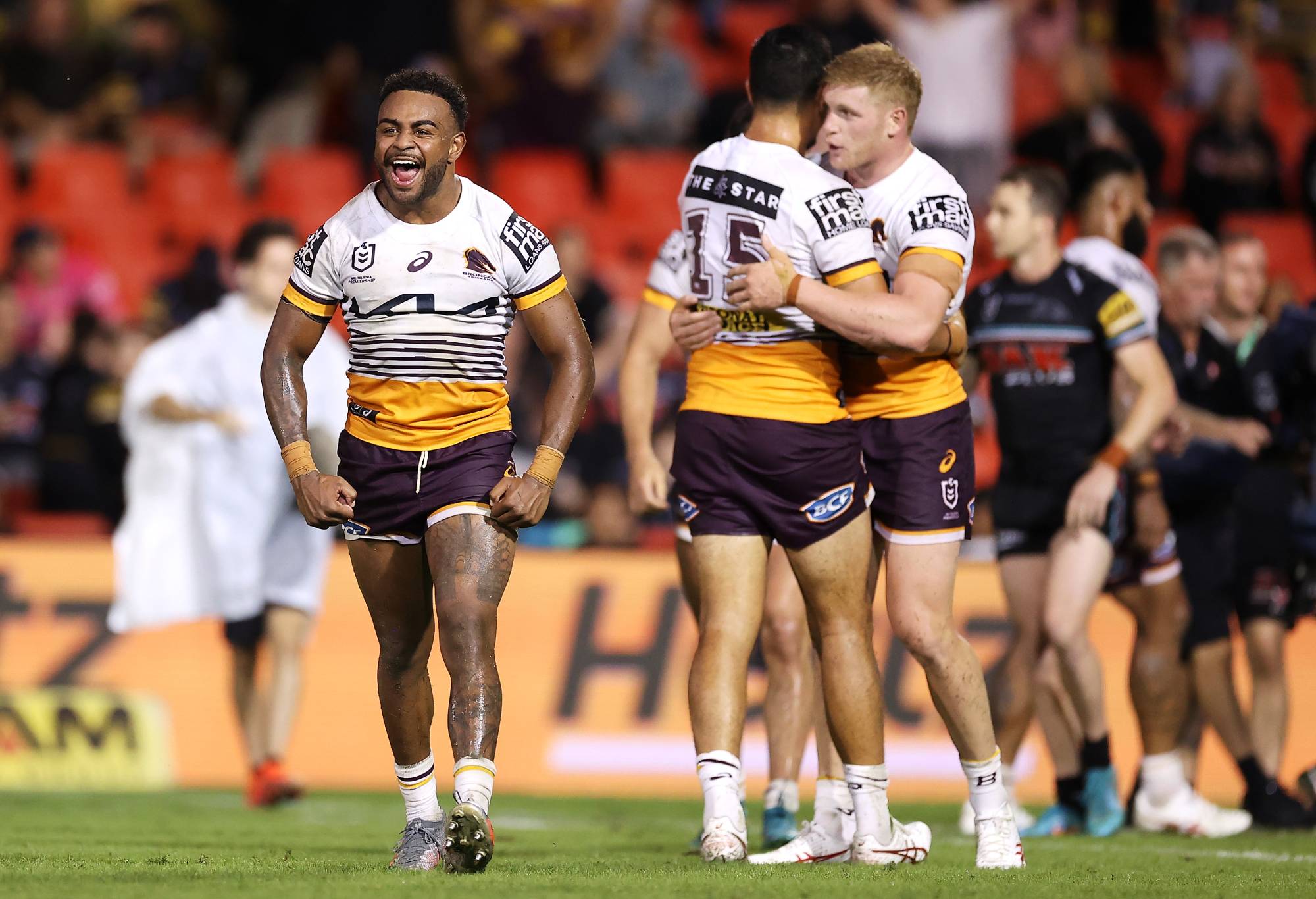In the grand scheme of rugby league feuds, a five-eighth giving an interchange back-rower a dressing down in the immediate aftermath of a defeat probably isn’t going to make an all-time list.
But when that player is Jarome Luai, everyone’s favourite love-to-hate, and the other bloke is Jaeman Salmon, known more for his playing style as a 12-year-old due to Ricky Stuart’s infamous sledge than as a premiership winner, then column inches will follow.
The pair’s public falling out has caused plenty of debate, but few have questioned what it was that they were actually discussing.
Luai’s issue appeared to be that Salmon wasn’t positioned where he needed to be late in their defeat to Brisbane on Friday night, and while it might have been better made in the privacy of the sheds, he had a fair point.
The Samoa international had copped plenty all night, with Kotoni Staggs gleefully leathering him on several occasions, and was regularly forced to take contact due to having nobody to pass to – his critique of Salmon.
To a large extent, that was a system function, however. The Panthers were incredibly left-dominant against the Broncos, going that way nearly twice as frequently as they went to the edge with Stephen Crichton and Brian To’o.
Ivan Cleary said post-game that he saw enough in their attack to encourage him going forward, but in video, he might be asking why Staggs found it so easy to spot up one of his key playmakers. By the end, Penrith were playing almost entirely on one side. They’d become very predictable.
Romey might not have had his best night at the office, but having a crunching tackler know that the ball is coming over and over again doesn’t help.
The Panthers scored with a big right shift early on and then promptly ignored that side for the rest of the game. Brisbane must have been laughing.
It’s entirely possible that the inability of Penrith to maximise their attack on Friday night is just a function of early-season rust. They went left a lot last year, too, and scored plenty of tries from it, and with Luke Garner and Sunia Turuva new to the team, it could be that the combos will just take time to come together.
But how teams split, and how they favour one side over the other, is a crucial thing that the opposition analysts will pick out and, well, analyse.
It was at play on Saturday night, too, and if you were listening closely to the commentary during South Sydney’s win over Cronulla, you would have noticed.
Greg Alexander and Dan Ginnane on the Fox call became slightly obsessed with a perceived dominance to the right hand side, a willingness to go in that direction rather than their fabled left, the edge that had seen Latrell Mitchell and Cody Walker feed Alex Johnston almost all of his 83 tries in the last three seasons.

(Photo by Mark Kolbe/Getty Images)
The performance of Lachlan Ilias, the halfback who is more regularly stationed out on the right, stole the headlines and rightly so. But for him to be able to have the influence that he did, the ball had to go that way in the first place.
Souths already had arguably the best edge in the comp on the left, but it suffered because you knew that, inexorably, that’s where they’d go when it mattered. Now…who knows? The right is in play and it’s a big bonus to have that unpredictability.
If you were watching the earlier game between Manly and the Bulldogs, this aspect of the game might have caught your eye too.
The Sea Eagles already had one of the best strike edges around in Haumole Olakau’atu, but now they‘ve got another in Kelma Tuilagi – but the imbalance remained, because the left absolutely dominated the right.
It’s interesting because, ahead of time, one would have thought that Manly would be split and the Dogs would struggle, given the new pairing for the Sea Eagles and the historical tendency of the Bulldogs to favour Matt Burton over Kyle Flanagan.
Last year, Canterbury were the most left-dominant side in the NRL, perhaps not surprising when one edge had Josh Addo-Carr at the end of it and the other had Jayden Okunbor. The fall guy was Flanagan, who ended up in the bottom 20% of halfbacks for touches per game.
He wasn’t overly effective on a per touch basis, but even so, he got so much less of it that it materially affected any judgement of his game.
This weekend, however, it was almost equal between the pair. The Dogs didn’t profit yet, but even though they have now added Viliame Kikau to that Burton/Foxx edge, they tried to play more equally. It’s an encouraging development if they continue splitting equally.

Kyle Flanagan (Photo by Jason McCawley/Getty Images)
It’s worth cycling back to mention why this matters. The NRL is a left-dominant competition, and perhaps unsurprisingly so: most people are right handed, meaning most halves are too, and throwing the ball, particularly for longer spiral passes, is more natural right to left.
The upshot of this is that the bulk of fast, tryscoring wingers play on the left, whereas more workhorse wingers play on the right. AJ, Foxx, Corey Oates are all left; To’o, Dom Young, Joseph Suaali’i all right.
The average imbalance in 2022 was 32%, meaning that teams shifted left a third more frequently than right. It wasn’t shared across the board, but only two teams – the Warriors and Sharks – were right-dominant and four might be called equal, with the other ten sticking with the dominant hand.
When a side is so clearly going to go one way, it makes them far easier to defend. The Dogs and Tigers went left at twice the rate they went right, so there was no honesty in the defence. They could hold one side and simply slide to meet the other.
It didn’t affect everyone – the 2022 Panthers, Roosters and Bunnies scored plenty while also being imbalanced – but they typically also played through a ball-playing lock, which ensures the defence cannot readily slide lest the 13 go themselves.
It’s an interesting way to read attacks, particularly in good ball. The 2022 Roosters, for example, were quite left dominant but also happy to play to points and set up a kick, which often went right to aim at the edge of Joey Manu and Suaali’i. The shift was often simply a set up play.
Souths did the opposite, using either a middle – Tom Burgess is an expert – or the right back-rower, Keoan Koloamatangi, to win a play the ball on the right tramline, from which they could swing Ilias, Murray, Walker and Mitchell into action on the left.
Other, less successful sides ended up playing side to side with it, however, and the Dogs and Tigers were the worst offenders. Attacks often died before Luke Brooks had the chance to kill them.

(Photo by Mark Kolbe/Getty Images)
There’s nothing inherently wrong with being dominant to one side, but, as Penrith found out, it is potentially limiting early in the year before the rustiness has worn off. If the other side know you’re coming, it does make their life easier.
That said, everyone knew Arjen Robben was going to cut in off the wing, but he still sent a hundred curling shots into the top corner. Every batsman in the world has seen the Ravichandran Ashwin arm ball, but they still get out to it.
The difference is that you need the opposition to think that the alternative is an option, even if it is a ruse to unleash your best weapon. Like so many batsmen, they play for the ones that spin and get done by the one that doesn’t.
Souths were not notably right-dominant on Saturday, but the threat of their left helped them build success on the right. Penrith became predictable when they wouldn’t play both sides equally.
That, rather than how well Jaeman Salmon positioned himself, might be the thing worth arguing about.































































































